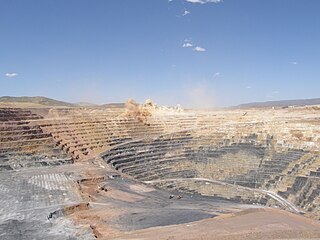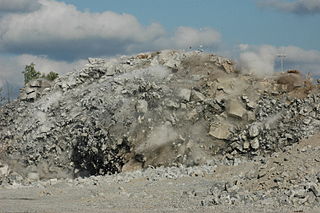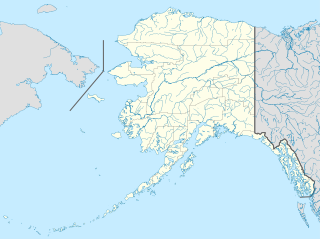
Mining is the extraction of valuable minerals or other geological materials from the Earth, usually from an ore body, lode, vein, seam, reef or placer deposit. These deposits form a mineralized commodity that is of economic interest to the miner.

A gunnies, gunnis, or gunniss is the space left in a mine after the extraction by stoping of a vertical or near vertical ore-bearing lode. The term is also used when this space breaks the surface of the ground, but it can then be known as a coffin or goffen. It can also be used to describe the deep trenches that were dug by early miners in following the ore-bearing lode downwards from the surface – in this case they are often called open-works; their existence can provide the earliest evidence of mining in an area. William Pryce, writing in 1778, also used the term as a measure of width, a single gunnies being equal to three feet.

Open-pit mining, also known as open-cast or open cut mining, is a surface mining technique of extracting rock or minerals from the earth by their removal from an open-air pit, sometimes known as a borrow.

Shaft mining or shaft sinking is excavating a vertical or near-vertical tunnel from the top down, where there is initially no access to the bottom.

Drilling and blasting is the controlled use of explosives and other methods such as gas pressure blasting pyrotechnics, to break rock for excavation. It is practiced most often in mining, quarrying and civil engineering such as dam, tunnel or road construction. The result of rock blasting is often known as a rock cut.

Uranium mining is the process of extraction of uranium ore from the ground. The worldwide production of uranium in 2019 amounted to 53,656 tonnes. Kazakhstan, Canada, and Australia were the top three producers and together account for 68% of world uranium production. Other important uranium producing countries in excess of 1,000 tonnes per year were Namibia, Niger, Russia, Uzbekistan and China. Uranium from mining is used almost entirely as fuel for nuclear power plants.
Mine exploration is a hobby in which people visit abandoned mines, quarries, and sometimes operational mines. Enthusiasts usually engage in such activities for the purpose of exploration and documentation, sometimes through the use of surveying and photography. In this respect, mine exploration might be considered a type of amateur industrial archaeology. In many ways, however, it is closer to caving, with many participants actively interested in exploring both mines and caves. Mine exploration typically requires equipment such as helmets, head lamps, Wellington boots, and climbing gear.

The Challenger mine is a gold mine in the Far North of South Australia, 165 km west of the Stuart Highway and 740 km north-west of Adelaide. It was operated by Dominion, Kingsgate and then WPG Resources. The mine is now on Care and Maintenance. The deposit was named by the geologist who discovered it, after his dog.

Soil nailing is a construction remedial measure to treat unstable natural soil slopes or as a construction technique that allows the safe over-steepening of new or existing soil slopes. The technique involves the insertion of relatively slender reinforcing elements into the slope – often general purpose reinforcing bars (rebar) although proprietary solid or hollow-system bars are also available. Solid bars are usually installed into pre-drilled holes and then grouted into place using a separate grout line, whereas hollow bars may be drilled and grouted simultaneously by the use of a sacrificial drill bit and by pumping grout down the hollow bar as drilling progresses. Kinetic methods of firing relatively short bars into soil slopes have also been developed. Bars installed using drilling techniques are usually fully grouted and installed at a slight downward inclination with bars installed at regularly spaced points across the slope face. A rigid facing or isolated soil nail head plates may be used at the surface. Alternatively a flexible reinforcing mesh may be held against the soil face beneath the head plates. Rabbit proof wire mesh and environmental erosion control fabrics and may be used in conjunction with flexible mesh facing where environmental conditions dictate.

The following outline is provided as an overview of and topical guide to mining:

Stoping is the process of extracting the desired ore or other mineral from an underground mine, leaving behind an open space known as a stope. Stoping is used when the country rock is sufficiently strong not to collapse into the stope, although in most cases artificial support is also provided.

Boring is drilling a hole, tunnel, or well in the earth. It is used for various applications in geology, agriculture, hydrology, civil engineering, and mineral exploration. Today, most earth drilling serves one of the following purposes:

Mining in the Upper Harz region of central Germany was a major industry for several centuries, especially for the production of silver, lead, copper, and, latterly, zinc as well. Great wealth was accumulated from the mining of silver from the 16th to the 19th centuries, as well as from important technical inventions. The centre of the mining industry was the group of seven Upper Harz mining towns of Clausthal, Zellerfeld, Sankt Andreasberg, Wildemann, Grund, Lautenthal und Altenau.

The Kemi Mine is owned by Outokumpu Chrome Oy, a subsidiary of Outokumpu Oyj. It is located in Elijärvi, in the municipality of Keminmaa, to the north of Kemi. The Kemi Mine is the largest underground mine in Finland, with an annual production capacity of 2.7 million tonnes of ore. It is also part of the integrated ferrochrome and stainless steel manufacturing chain owned by Outokumpu in the Kemi-Tornio region. The Kemi Mine has approximately 400 employees every day, both employees of Outokumpu and contractors.
Mopani Copper Mines PLC ("Mopani") is a Zambian registered company owned by Carlisa Investments Corporation and ZCCM-IH (10%). Minority shareholders are spread throughout the world, in various locations.

The Pogo mine is a gold mine in the state of Alaska. By 31 December 2017 Pogo had produced 3.6 million ounces of gold at a grade of 13.6 g/t. Annual production for 2019 was 159,344 ounces. At 31 December 2019 the mine had Proven and Probable Reserves of 1.5 million ounces of gold at a grade of 7.5 g/t (JORC). It is located 30 miles (48 km) northeast of Delta Junction and 135 miles (217 km) east of Fairbanks.
LHD loaders are similar to conventional front end loaders but developed for the toughest of hard rock mining applications, keeping overall production economy, safety, and reliability in consideration. They are extremely rugged, highly maneuverable, and exceptionally productive. More than 75% of the world's underground metal mines use LHD for handling the muck of their excavations.
Deep level underground is constructions 20 metres or more below ground and not using the cut-and-cover method, especially train stations, air raid shelters and bunkers and some tunnels and mines. Cut-and-cover is a simple method of construction for shallow tunnels where a trench is excavated and roofed over with an overhead support system strong enough to carry the load of what is to be built above the tunnel.
The Rajpura Dariba Mine VRM disaster took place in Dariba, Udaipur on 28 August 1994 at a mine operated by Hindustan Zinc Ltd.

Rock Bolting Development Site is a heritage-listed former rock bolt experiment site at Sharp Street, Cooma, Snowy Monaro Regional Council, New South Wales, Australia. It was used by Snowy Mountains Hydro-Electric Authority personnel from 1956 to 1962. It was added to the New South Wales State Heritage Register on 23 December 2016.



















